|
Dutch
Barn Preservation Society
Dedicated
to the Study and Preservation
of New World Dutch Barns
NEWSLETTER
FALL 2003, Vol. 16, Issue 2, part two
The big Gooi-style
farmhouse at Greenbush after over fifty years be came very dilapidated.
When Jeremias Van Rensselaer, who became Director of the Rensselaerswyck
colony in 1660 took over the farm at Greenbush for his own (and
named it Crailo), he refused to use the old farmhouse because
of the expense of maintaining it. But he did not tear it down.
In 1661 Van Rensselaer leased the farmhouse at Greenbush, (but
not the farm) to Willem Bout for six years, on the condition
that repairs to the building were to be at Bout's expense. Bout,
to whom the Greenbush sawmills belonged, complained often that
he did not care to live in the run-down farmhouse because of
the costs. Jeremias van Rensselaer noted, however, that the house
was conveniently located for Bout because it was close to the
mill on the present day Red Mill Creek. Bout was not allowed
to build any new structure close to the mill nor to pile firewood
or hay near the mill.
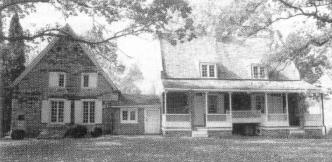 Figure
12. The two side by side Bronck houses surviving at Leeds, New York,
show two different styles for country houses. The older house of
1663 is at left. Photo by Robert Andersen. Figure
12. The two side by side Bronck houses surviving at Leeds, New York,
show two different styles for country houses. The older house of
1663 is at left. Photo by Robert Andersen.
In November,
1662, Van Rensselaer and Bout altered their agreement into an
arrangement for rent of a small part of the farm. Bout was to
keep the house and the out buildings at Greenbush as he had previously
had them. He was also to have a good work horse and a heifer.
In 1670, a complaint was made that Willem Bout's horses at the
mill sometimes got into the Greenbush farmer's fields. About
the time Bout died in 1683 the decrepit farmhouse of 1632 may
have been abandoned.(12) The Greenbush farmhouse did not wash
away in the famous flood of 1666 which destroyed many buildings,
including the matching farmhouse on Castle Island. Because it
was rented, the old farm house at Greenbush probably lasted longer
than most of the others of its type. By 1668, the one at the
Flatts fell in and had to be rebuilt.113) It appears the big
Gooi farmhouses were not practical in the cold Hudson Valley
climate of the 1600s. On the additional Rensselaerswyck farms,
residences began to be built separately from the barns.
Cellars, at
first merely holes in the ground framed with boards under the
living area of a farmhouse, were needed to provide frost free
storage for root crops and fruit. For example, in Arent Van Curler's
long farmhouse on the Flatts, there was to be a small cellar
under the dwelling section. As the free-standing farm residences
became common, full cellars made of stone gradually replaced
the partial cellars. These stone foundations now supporting the
residence avoided frost heave and rot, which probably had afflicted
the large farmhouse combinations.
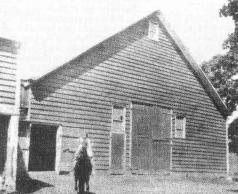 Figure
11. A late twentieth-century photo of the Van Bergen barn shows
the roof had been altered. Photo by Jeanne Litwin. Figure
11. A late twentieth-century photo of the Van Bergen barn shows
the roof had been altered. Photo by Jeanne Litwin.
The Dutch barns, I believe, in being separated from the farm residence,
retained the framing shown in Jaap Schipper's sketch of the Gooi
barn, with possibly the elimination of an angle in the roof slope
over the side aisles. [Figure 11] A photograph shows.the a1tered
framing of the roof of the 1680 Van Bergen barn. Whether this change
was merely to raise the roof for more hay storage, or whether it
was to eliminate the break in the pitch is not known. In the Netherlands,
there was a short age of long timbers for rafters, while here,.
due to the long timbers available, there was no need for a rafter
splice over the side aisles. In another adaptation after residences
were separated from the barns, the big wagon door was brought around
from the side of the barn to the gable end, thus avoiding the need
to raise the eaves for a wagon door.
The Gooi barn and the Kiliaen van Rensselaer's letters help us
to understand why some house contracts of the seventeenth-century
in the Hudson Valley called for houses which were wider than deep.
[Figure 12: Two Bronck houses, 1663 and 1738, side by side.] The
Bronck house of 1663, for example, is 26 feet across the front,
while it is only 22 feet deep, modern measure. I am not suggesting
that this particular house once had a barn attached at the rear,
although it might have, since
it has the right proportions to be the residence part of a longhouse.
In another example, the living section of the longhouse built on
the Flatts by Arent Van Curler was to be 28 feet wide by only 20
feet in depth, again wider than it was deep.
Thus the wider than deep
pattern in houses may reflect proportions established when Van
Rensselaer's Gooi longhouses were erected.
This brings into question
our assumption that any Dutch-style house with its front door
in the gable end is an urban-style house, while houses such as
the second Bronck house of 1738, with a ridge running parallel
to the road, are thought to be "country-style."
Actually, the tradition of a gable end to the road is an ancient
one, not limited to cities. As we have seen, country farmhouses
with attached barns in the Gooi style had to be entered from the
gable end and this may explain why the occasional Hudson Valley
Dutch country house gable faces the road.
Summary
The longhouses of the Gooi land were, just as Kiliaen Van
Rensselaer intended, one big efficient rectangle. They served their
purpose, providing quick shelter for farm families, farm help,
stock and crops in the first years of farm settlement here. These
special European farmhouses of the Gooi once were a part of our
landscape. They are documented by letters, by archeology, and by
Dutch architectural. studies. Moreover, their framing style set
the pattern for the Dutch-American barns of the next two centuries,
and influenced house shapes as well. This large, influential (but
little appreciated) European style building lurks in the background
of our architectural history.
EXTRA
I will read you a story about the farmhouse in Greenbush which
has nothing to do with architecture.
In 1632 an unpopular man, Hans Joris Hontum, was selected to
be commissioner of Fort Orange. The Mohawk Indians hated him because
a decade earlier he had cold-bloodedly murdered a captive Mohawk
chief after the chief's ransom had been paid. When he arrived at
Fort Orange, the Mohawk Indians rose up in violence, killed cattle
(including at Greenbush), and burned a yacht. They threatened to
kill Hontum, and refused to trade with him.
More violence followed the appointment of Hontum. Within a year
he was stabbed to death in Van Rensselaer's farmhouse at Greenbush
by Cornel is van Vorst, chief officer of Pavonis, a patroonship
near New Amsterdam. The details were given by Cornel is Maesen
(Van Buren), who returned to the Netherlands in 1634 after three-and-a-half
years as a farmhand in Rensselaerswyck. Cornelis Maesen, who had
gone outside just before the fight began, heard the details from
the others present. He explained that Hontum, by order of the Dutch
West India Company directors, had posted a placard restricting
trade with the Indians. Cornel is van Vorst resented this regulation
and held it against Hontum. When van Vorst visited Hontum at Fort
Orange in April 1634, they began to drink together. Then the pair
crossed the river to visit the "dwelling and farm of Rensselaer
where he, the deponent [Cornel is Maesen] resided." The two
officials entered the house on the Greenbush farm, in which, after
drinking some more, van Vorst made insults against council members.
When Hontum struck him in the face, van Vorst drew his sword and
fatally stabbed him.
Notes:
(1) Jonathan Pearson, trans. And A. J. F. Van Lear, ed., Early
Records of Albany, Vol. 2, (Albany: University of the State
of New York, 1916), p. 154; Early Records of Albany, Vol.
3, (Albany: University of the State of New York, 1918, pp. 508-509).
(2) A. J. F. Van Lear, Trans. And ed., Van Rensselaer Bouwier
Manuscripts (Albany, NY 1908) p. 308 [hereafter cited as VRBM.
(3) Ibid, p. 309.
(4) From J. J. Voskuil, Van vlechtwerk tot baksteen, (Stichting
Historisch Boerderij-Onderzoek, Arnhem, The Netherlands, 1979),
po, 35, copied with permission.
(5) "Settlement Patterns in Rensselaerswyck: The Farm at
Greenbush," de Halve Maen Magazine, Summer, 2002, Vol.
LXXV, No.2, p. 23).
(6) VRBM, p. 309.
(7) VRBM, p. 520.
(8) Paul R. Huey, "Archeological Evidence of Dutch Wooden
Cellars,"
in New World Dutch Studies: Dutch Arts and Culture in Colonial
America, Albany Institute of History and Art, 1987, pp. 14-16;
A. J. F. Van Laer,
"Translation of the Letter of Arent Van Curler To Kiliaen
Van Rensselaer," Dutch Settlers Society of Albany Yearbook,
Vol. 3 (1927-28), p.2l.
(9) Shirley Dunn, "Settlement Patterns: the Farm at Greenbush," de
Halve Maen, Summer, 2002, Vol. LXXV, No. 2, p. 23.
(10) VRBM, p. 820.
(11) J. Franklin Jameson, Narratives of New Netherland (1909)
reprint, New York: Barnes & Noble, Inc., 1967, p. 262.
(12) For details given in this paragraph, see Dunn, "Settlement
Patterns: Greenbush," de Halve Maen, Fall 2002, p.
50. For Bout's death see Jonathan Pearson, Contributions for
the Genealogies of the First Settlers of the County of Albany,
reprint, Genealogical Publishing Co. 1978, p.5.
(13) In. 1666, the patroon's house in Albany where Jeremias and
his wife, Maria, lived was washed away by a catastrophic April
flood on the Hudson River. Almost all their possessions and papers
were lost as well as the colony's grain stored for shipment. Many
other buildings onshore, as well as barns and houses on the islands,
were destroyed, but the Greenbush houses were exceptions. A few
days after the flood, Jeremias Van Rensselaer wrote, "My farm
in the Grene Bos is, thank God, saved beyond hopes which I had
of it. I lost there not more than two cows and one heifer, one
half of my hogs and a large part of my fencing." Correspondence
of Jeremias Van Rensselaer, A. J. F. Van Laer, trans. And ed.
(1932), p. 106. For the need to reconstruct the house at the Flatts,
see ibid, 407.
(14) John Stevens, "A Last Look at the Van Bergen-Vedder
Barn,"
Dutch Barn Preservation Society Newsletter, Spring 1995, Vol. 8,
Issue 1.
Shirley Dunn, historian, author, and lecturer
was one of the founders of the Dutch Barn Preservation Society
and its first president. Among her books is the monumental work, "The
Mohicans and Their Land."
WINDMILLS
OF HOLLAND
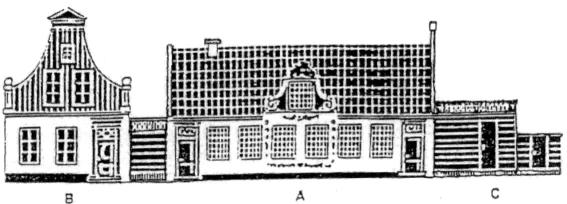
This brochure, received from Jaap Schipper, society member from
Amsterdam, Holland is included here to demonstrate how others handle
preservation with problems very similar to the American-Dutch barn.
Museum Building
The Windmill Museum was opened in 1928 by Prince Hendrik,
husband of Queen Wilhelmina.
For over 60 years, the windmill Museum has been housed in a reinstated
old Zaan merchant house, built around 1760 at Koog aan de Zaan
(A).
The brick facade facing the park side is richly decorated with
carved wooden ornaments.
The main building (A) is divided between a ground floor, the
model replica room with print cabinet and an upstairs department
devoted to crafts and technique.
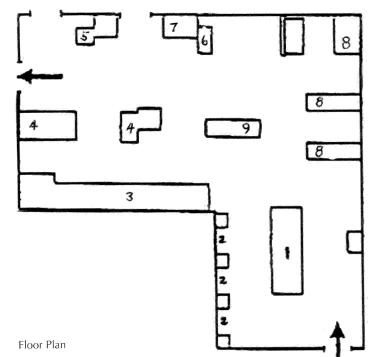 In
1982, the museum was doubled in size by reconstructing next to
the first building, a second merchant's house, originally built
in Zaandam (B). Of interest in this building is the authentic roof
beam construction from the 17th century using curved oak beams
as corbel. In this part of the museum (B), is downstairs a space
for changing exhibits and upstairs an exhibit about the history
of windmills. In
1982, the museum was doubled in size by reconstructing next to
the first building, a second merchant's house, originally built
in Zaandam (B). Of interest in this building is the authentic roof
beam construction from the 17th century using curved oak beams
as corbel. In this part of the museum (B), is downstairs a space
for changing exhibits and upstairs an exhibit about the history
of windmills.
In 1989, the museum was further expanded with a panorama room
(C) which includes the "Zaan Windmill Panorama" by Frans
Mars.
1. Models of windmills
The first object to catch your eye is the large-scale model
of the paper windmill "De Eendracht", constructed at
the workshop of P. Wakkar at Wormer in 1900 (A). Seven men worked
on it for more than six months.
2. The information panels
The Netherlands has long been known for its windmills. Around
the middle of the last century, there were still 9000 of them.
However, through fire and demolition, the number of windmills has
been drastically reduced. Now there are only about 1000 remaining.
Whoever wants to see this still existing heritage has many opportunities.
Windmills are spread throughout the land and in large variety.
The industrial development along the Zaan river began about 1600,
progressing greatly in the 17th and 18th centuries. Lumber was
sawed, oil pressed, paper was made, rice and barley peeled, cloth
fulled, hemp pounded, grain, snuff, cocoa, color pigments, spices
and mustard seed ground. (Green lamps indicate the still existing
windmills.)
By 1730, roughly 600 mills were running simultaneously in the
Zaan district. After 1750, prosperity slackened. A difficulty period
ensued which saw the destruction of many mills. The arrival of
the steam engine in the industrial revolution after 1870 meant
still further damage. By the turn of the century, even more windmills
disappeared through fire or demolition. Presently, there are only
a small amount left over, most of which are in the possession of
the Zaan Windmill Association.
3. Drainage Mills
In the Netherlands windmills were used for the reclamation
of land from lakes. The firth drainage mills used a paddle-wheel
to draw up the water. Since 1650 an Archimedean screw made from
wood has been used as well, enabling the water to be drawn up from
a considerable lower level. The Polder windmills in the Low Countries
called Noordholland have no tail construction in order to revolve
the cap and put the sails into the wind. The caps of these windmills
are turned by means of an inside winding gear.
4. Sawmills
The first saw mill was built in the year 1592. The Zaan district
once numbered about 240 Poltrok saw mills which revolve as a whole.
The much larger type sawmill with revolving cap and reefing platform
was used for sawing the largest trunks.
5. Wind mills
The oil windmills produced vegetable oil and cattle food by
grinding different kinds of oil seeds and expelling the oil at
high pressure. One of the scale models shown here was made by J.
Nanning around the year 1796 by candlelight in his free time.
6. Dye windmills
In the dye windmills, the wood containing pigments was ground
to powder. With these colours, wool, silk and cotton clothes were
dyed. Pigment mills pulverized minerals to powder which artists
used to lubricate paints.
7. Peeling windmills
With the help of rotating stones, the hull of barley and rice
was peeled.
8. Guilded bronze models
The bronze models were produced in 1928 by "Ateliers
A. Schoorl"
to the design of P. Boorsma, one of the Zaan district's best windmill
experts.
9. Wooden models
These miniatures, made from tropical wood, were created between
1938 and 1948 from designs by Jos van der Horst.
MOLENMUSEUM/ Museum/aan 78/ Koog a/d Zaan, Netherlands.
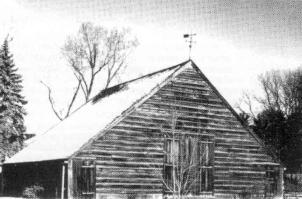
The Wortendyke Barn Museum is an excellent community
attraction at 13 Pascack Road in Park Ridge, N.J. Photo by Curator
Robert L. Cohen.
NEW FITCHEN BOOK RECEIVES AWARD
Congratulations to Greg Huber, recipient of the Allen G. Noble
Book Award for the best edited book in North America, for 2003,
given by the Pioneer America Society. Greg received the award for
his editing and expanding with new research the original work of
John Fitchen in his 1968 published book, The New World Dutch
Barn. Readers may enjoy the review of Greg's book by Peter
Sinclair, which appeared in the Fall 2001 issue of the Dutch Barn
Preservation Society Newsletter.
|